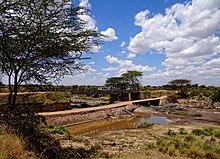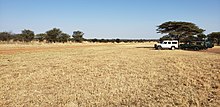Serengeti (district)
| Serengeti District | |
|---|---|
 Location of the Serengeti District in Tanzania |
|
| Basic data | |
| Country | Tanzania |
| region | Mara |
| surface | 10,373 km² |
| Residents | 249,420 (2012) |
| density | 24 inhabitants per km² |
| ISO 3166-2 | TZ-13 |
Coordinates: 1 ° 50 ′ S , 34 ° 24 ′ E
Serengeti is the largest district in the Mara region with the administrative center in Mugumu . It borders on Kenya and the Tarime district to the north, the Arusha region to the east, the Simiyu region to the south and the Bunda and Butiama districts to the west .
geography
The district is 10,373 square kilometers and has around 250,000 inhabitants (as of 2012). The Serengeti National Park and the Ikorongo and Grumeti game reserves account for over 7,000 square kilometers . There are four seasons in Serengeti: a rainy season with brief showers from August to December, followed by a dry season. A rainy season with heavier precipitation lasts from February to April, followed by a dry season. According to the effective climate classification, the climate is a tropical savannah climate (Aw). The land slopes from east to west:
- The highlands in the east have a height between 1,800 and 1960 meters, the rainfall is 1200 millimeters per year.
- In the hill country, which is between 1400 and 1800 meters above sea level, there is an annual rainfall of 1000 to 1200 millimeters.
- The plain in the west is 1200 to 1400 meters above sea level and there are 600 to 1000 millimeters of precipitation.
In the rainy season the average temperature is 24 degrees Celsius, in the dry season it is 26 degrees Celsius.
history
The Serengeti District was founded in 1975 after the division of the former South Mara District.
Administrative division
The district is divided into four districts with 30 parishes (wards):
- Kenyamonta
- Busawe
- Kisaka
- Kebanchabancha
- Ring'wani
- Rung'abure
- Machochwe
- Kisangura
- Mugumu
- Ikoma
- Natta
- Issenye
- Rigicha
- Nyambureti
- Nyamoko
- Manchira
- Kyambahi
- Nyamatars
- Majimoto
- Magange
- Nyansurura
- Mosongo
- Sedeco
- Mbalibali
- Stendi Kuu
- Geitasamo
- Morotonga
- Uwanja wa Ndege
- Nagusi
- Matare
population
|
The best-known ethnic group in the district are the Maasai , who despite western cultural influences have partially preserved their semi-nomadic way of life and their traditions. Other ethnic groups in the district are the Waikoma, Wakuria, Wasukuma, who make a living from agriculture but also have a small number of livestock. The literacy rate of those over fifteen rose from 63 percent in 2002 to 76 percent in 2012, for men from 78 to 83 and for women from 57 to 67 percent. Of those over five years old, 54 percent could read and write swahili , one percent only in English and nine percent swahili and English. |
 |
Facilities and services
educationIn 2015 there were 106 elementary schools and 24 high schools in the district. 32 percent of those over five attended school, eight percent dropped out without a qualification, 34 percent had a school leaving certificate and 26 percent had not attended school (as of 2012). healthThere was one hospital, two health centers and 49 pharmacies in the district (as of 2015). |
 |
water
The water requirement for humans and animals is 42,000 cubic meters per day. Currently, 24,000 cubic meters can be made available. Forty percent of households in the district have access to water within 400 meters (as of 2018).
Economy and Infrastructure
In 2012, 60 percent of those over the age of ten were gainfully employed, 20 percent worked in the household, 13 percent were schoolchildren or students, 3 percent were unemployed and 4 percent unable to work. 58 percent of households had a radio, seven percent a television, 60 percent had a mobile phone and one percent a car.
AgricultureNinety percent of the population live from agriculture. The main crops are cassava, corn, millet and sweet potato. Cotton, beans and tobacco are also grown on a small scale. In 2012, 17,000 cattle, 15,000 goats, 10,000 sheep and 24,000 poultry were kept as farm animals. |
 |
Mining
In terms of mineral raw materials, limestone is extracted in Nyigoti, slate in Marasomoche and gypsum in Robanda. There are gold deposits in Nyigoti, Ring'wani, Borenga and Majimoto, in Majimoto helium is also found.
traffic
- Roads: There are 180 kilometers of main roads, 220 kilometers of regional roads and 800 kilometers of secondary roads in the district. In the rainy season, around 70 percent of the roads are passable. The most important connection is the national road T17, which connects the regional capital Musoma in the west with Arusha in the east.
- Air traffic: The five natural slopes Lobo, Seronera, Fort Ikoma, Sasakwa Hill and Burunga connect the district with the local airport in the regional capital Musoma.
Web links
Serengeti District Mara Region
Individual evidence
- ^ Tanzania Regional Profiles, Mara. Retrieved October 12, 2019 .
- ^ Serengeti District Council, About Us, Historia. The United Republic of Tanzania, accessed November 2, 2019 (Swahili).
- ↑ Climate Data, Tanzania, Mugumu. Retrieved November 2, 2019 .
- ↑ Serengeti District Council, Strategic Plan 2016/2017 - 2020/2021. (pdf) The United Republic of Tanzania, pp. 5–6 , accessed on November 2, 2019 .
- ^ Mara Region, Serengeti District, Historia. The United Republic of Tanzania, accessed November 2, 2019 (Swahili).
- ↑ Serengeti District Council, Strategic Plan 2016/2017 - 2020/2021. (pdf) The United Republic of Tanzania, pp. 6–7 , accessed on November 2, 2019 .
- ↑ About Serengeti. Retrieved November 3, 2019 .
- ↑ Tanzania Regional Profiles, 20 Mara Regional Profiles. (pdf) The United Republic of Tanzania, 2016, pp. 69, 72 , accessed on October 24, 2019 .
- ↑ Serengeti District Council, Strategic Plan 2016/2017 - 2020/2021. (pdf) The United Republic of Tanzania, p. 12 , accessed on November 2, 2019 .
- ↑ Tanzania Regional Profiles, 20 Mara Regional Profiles. (pdf) The United Republic of Tanzania, 2016, p. 79 , accessed on November 2, 2019 .
- ↑ Serengeti District Council, Strategic Plan 2016/2017 - 2020/2021. (pdf) The United Republic of Tanzania, p. 13 , accessed on November 2, 2019 .
- ^ Serengeti District Council, Services, Water. Retrieved November 2, 2019 (Swahili).
- ↑ Tanzania Regional Profiles, 20 Mara Regional Profiles. (pdf) The United Republic of Tanzania, 2016, p. 94 , accessed on November 2, 2019 .
- ↑ Tanzania Regional Profiles, 20 Mara Regional Profiles. (pdf) The United Republic of Tanzania, 2016, pp. 124–125 , accessed on November 2, 2019 .
- ↑ Serengeti District Council, Strategic Plan 2016/2017 - 2020/2021. (pdf) The United Republic of Tanzania, pp. 8–9 , accessed on November 2, 2019 .
- ↑ Tanzania Regional Profiles, 20 Mara Regional Profiles. (pdf) The United Republic of Tanzania, 2016, p. 133 , accessed on November 2, 2019 .
- ↑ a b c Serengeti District Council, Strategic Plan 2016/2017 - 2020/2021. (pdf) The United Republic of Tanzania, p. 11 , accessed on November 2, 2019 .




